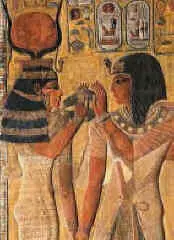The ancient Egyptians were very particular about their beauty and hairstyles.
Also, the hairstyles determined the status of a person in society. Wigs were popular amongst the upper and middle classes, the wealthier presumably maintaining a greater selection of wigs. Wigs were made by barbers or by wig specialists, one of the occupations open to Egyptian women.

Grey hair was hidden by the application of henna since the middle of the 4th millennium BCE at least. Sometimes it was tinted with an ointment containing the astringent juniper-berries and two other, unidentified plants which supplied the coloring agent. However, the wigs played an important role. Wigs were also considered necessary for the afterlife, they were buried in tombs, some contained in specialized wig chest.
Quite a few wigs have survived, in particular from the New Kingdom. By the time of the New Kingdom, styles had become more sophisticated. Both sexes wore their hair longer. The Egyptian Hair used in the construction of wigs and hair extensions was human, and was either an individual’s own hair or had been traded for, the hair itself is a valuable commodity ranked alongside gold and incense in account lists from the town of Kahun.
It is also quite apparent that women’s wigs were considerably less elaborate than those worn by men and consequently appear more natural. The best-preserved example of the long full style so favored by New Kingdom women was found inside the tall wooden wig box of Merit in the Deir el-Medina tomb she shared with her husband Kha. In addition to complete wigs, individual braids were employed to create wider and longer dimensions.
There were periods when the head was clean shaven, others when it was left to grow, cropped short or worn shoulder-long or even longer by both men and women. Priests are shown with cleanly shaved heads since the New Kingdom, but most people seem to have had some hair on their heads and taken good care of it, as the many remedies against hair loss or gray hair indicate. Young girls often had pigtails while boys had shaved heads.
As with modern women, ancient Egyptian women could maintain a hairstyle that was long or short, preferring their hair smooth and close with chin length bobs. For longer Egyptian Hair, women of the New Kingdom had wigs, their hair decorated with flowers or ribbons. Even the poorer women would be able to add adornments such as berries and petals, while children’s hair was decorated with amulets, hair-rings, and clasps.